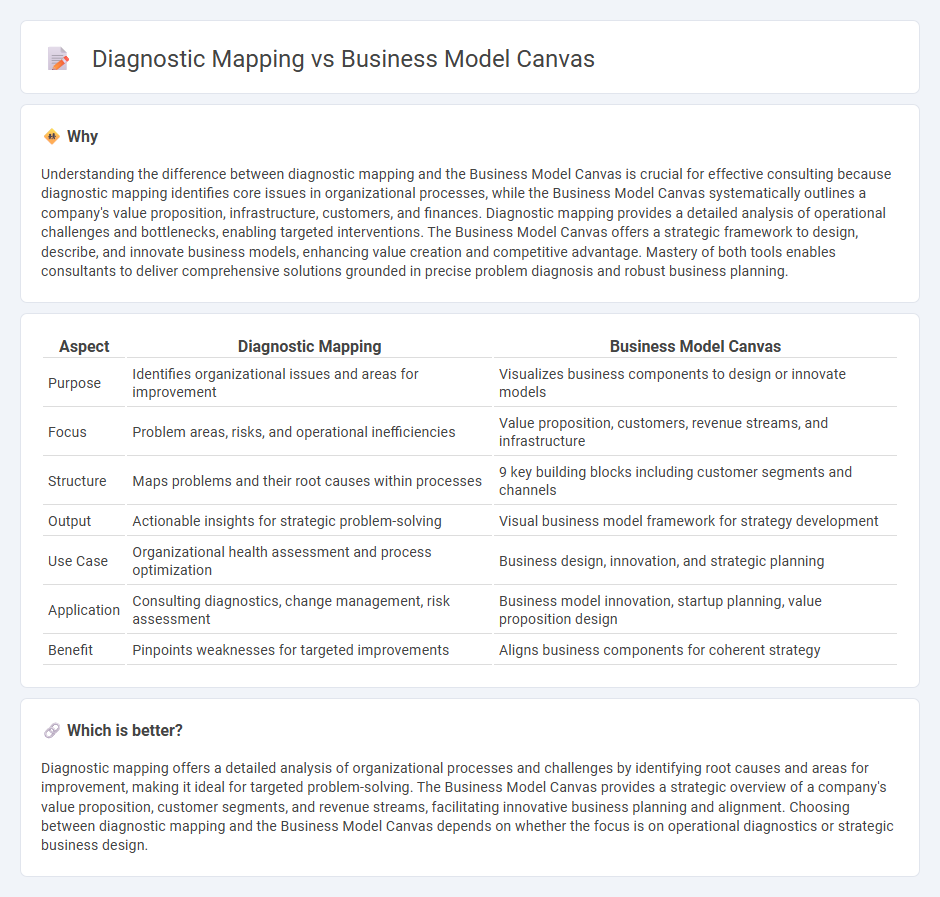
Diagnostic mapping identifies organizational challenges by visualizing processes, pain points, and stakeholder interactions for targeted problem-solving. Business Model Canvas structures a company's value proposition, customer segments, channels, revenue streams, and key resources to optimize strategic planning. Explore how combining these tools enhances consulting outcomes and drives sustainable business growth.
Why it is important
Understanding the difference between diagnostic mapping and the Business Model Canvas is crucial for effective consulting because diagnostic mapping identifies core issues in organizational processes, while the Business Model Canvas systematically outlines a company's value proposition, infrastructure, customers, and finances. Diagnostic mapping provides a detailed analysis of operational challenges and bottlenecks, enabling targeted interventions. The Business Model Canvas offers a strategic framework to design, describe, and innovate business models, enhancing value creation and competitive advantage. Mastery of both tools enables consultants to deliver comprehensive solutions grounded in precise problem diagnosis and robust business planning.
Comparison Table
| Aspect | Diagnostic Mapping | Business Model Canvas |
|---|---|---|
| Purpose | Identifies organizational issues and areas for improvement | Visualizes business components to design or innovate models |
| Focus | Problem areas, risks, and operational inefficiencies | Value proposition, customers, revenue streams, and infrastructure |
| Structure | Maps problems and their root causes within processes | 9 key building blocks including customer segments and channels |
| Output | Actionable insights for strategic problem-solving | Visual business model framework for strategy development |
| Use Case | Organizational health assessment and process optimization | Business design, innovation, and strategic planning |
| Application | Consulting diagnostics, change management, risk assessment | Business model innovation, startup planning, value proposition design |
| Benefit | Pinpoints weaknesses for targeted improvements | Aligns business components for coherent strategy |
Which is better?
Diagnostic mapping offers a detailed analysis of organizational processes and challenges by identifying root causes and areas for improvement, making it ideal for targeted problem-solving. The Business Model Canvas provides a strategic overview of a company's value proposition, customer segments, and revenue streams, facilitating innovative business planning and alignment. Choosing between diagnostic mapping and the Business Model Canvas depends on whether the focus is on operational diagnostics or strategic business design.
Connection
Diagnostic mapping identifies key organizational challenges and opportunities by analyzing internal processes and external environments, providing essential insights that feed into the Business Model Canvas. The Business Model Canvas then structures these insights into nine fundamental components, such as value propositions, customer segments, and revenue streams, facilitating strategic planning and innovation. This integration enables consultants to create tailored business strategies that align operational strengths with market demands for sustainable growth.
Key Terms
Value Proposition
Business Model Canvas emphasizes the Value Proposition by clearly defining the unique benefits and solutions a business offers to its customers, driving product-market fit and competitive advantage. Diagnostic Mapping focuses on identifying gaps and inefficiencies within existing value delivery to optimize or innovate the Value Proposition for enhanced customer satisfaction. Explore deeper insights into how these frameworks shape your strategic approach to value creation.
Root Cause Analysis
The Business Model Canvas emphasizes visualizing key components of a business such as value propositions, customer segments, and revenue streams, whereas Diagnostic Mapping targets identifying and analyzing root causes of business problems through systematic investigation. Root Cause Analysis in Diagnostic Mapping uncovers underlying issues by tracing symptoms back to their source, enabling effective problem-solving strategies that Business Model Canvas alone may not address. Explore how combining these tools enhances strategic decision-making by visiting our detailed guide.
Revenue Streams
The Business Model Canvas highlights Revenue Streams as the specific ways a company generates income from its value propositions, including direct sales, subscription fees, and licensing. Diagnostic Mapping focuses on identifying and analyzing revenue sources across an organization's operations to uncover inefficiencies and optimize profitability. Explore how integrating these approaches can enhance your understanding of revenue generation strategies.
Source and External Links
Business Model Canvas: Explained with Examples - Creately - The Business Model Canvas is a one-page strategic tool that breaks down a business idea into nine key elements focused on customers, business operations, and value exchange, helping teams visualize, assess, and improve a business model collaboratively.
Free download Business model canvas - Developed by Alexander Osterwalder, the Business Model Canvas is a structured framework used to understand and map key aspects like customer segments, value propositions, channels, revenue streams, and relationships in a straightforward way.
Create a Business Model Canvas Online | Canva - This visual framework offered through online customizable templates allows entrepreneurs to quickly outline and assess their business concept's viability and competitiveness by mapping customers, activities, costs, and revenue on a single page.
 dowidth.com
dowidth.com